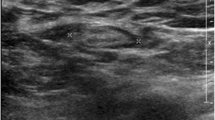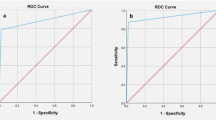Abstract
Purpose
Axillary lymph node assessment is an essential component of staging invasive breast cancer. One of the crucial issues in determining prognosis and treatment is the number of lymph nodes found by the pathologist. It is difficult to identify small lymph nodes among the surrounding fat. Fat-dissolving solutions have been introduced to dissolve fat, but their clinical benefit has yet to be evaluated. In this study, we compare 10% buffered formalin fixation and Carnoy's solution in revealing the axillary lymph node counts in modified radical mastectomy specimens.
Method
Fifty axillary tail specimens, taken from patients with invasive breast cancer who underwent modified radical mastectomy surgery, were randomly fixed in Carnoy’s solution or 10% buffered formalin. After 24–48 h of fixation, the total number and size of separated lymph nodes were examined by an expert pathologist.
Result
The average number of lymph nodes found in Carnoy and formalin solutions was 8 and 7.52, respectively, and the average number of metastatic lymph nodes found in these two solutions was 2.77 and 1.8, respectively. Moreover, the average size of the Carnoy group's lymph nodes was smaller than the formalin group, with no significant differences.
Conclusion
Compared to the formalin solution, taking into account the overall advantages of Carnoy's solution such as the same time of the preparation process, reduced carcinogenicity with only a slightly increased cost, using Carnoy's solution seems to be cost-effective in better staging and changing the patient's need for adjuvant treatments.
Similar content being viewed by others
References
Coughlin SS. Epidemiology of breast cancer in women. Adv Exp Med Biol. 2019;1152:9–29.
Wilkinson L, Gathani T. Understanding breast cancer as a global health concern. Br J Radiol. 2022;95(1130):20211033.
Abass MO, Gismalla MD, Alsheikh AA, Elhassan MM. Axillary lymph node dissection for breast cancer: efficacy and complication in develo** countries. J glob oncol. 2018;4:1–8.
Woods RW, Camp MS, Durr NJ, Harvey SC. A review of options for localization of axillary lymph nodes in the treatment of invasive breast cancer. Acad Radiol. 2019;26(6):805–19.
Jiang J, He QQ, Yang XH, Liang Y, Fan LJ, Zhang Y, Guo MQ. Contribution of minute axillary lymph nodes to accurate staging for patients with breast cancer. Chin med j. 2007;120(20):1762–5.
Chang JM, Leung JWT, Moy L, Ha SM, Moon WK. Axillary nodal evaluation in breast cancer: state of the art. Radiology. 2020;295(3):500–15.
Le VH, Brant KN, Blackhurst DW, Schammel CM, Schammel DP, Cornett WR, et al. The impact of the American college of surgeons oncology group (ACOSOG) Z0011 trial: an institutional review. Breast. 2016;29:117–9.
Verheuvel NC, Ooms HW, Tjan-Heijnen VC, Roumen RM, Voogd AC. Predictors for extensive nodal involvement in breast cancer patients with axillary lymph node metastases. Breast. 2016;27:175–81.
Dias AR, Pereira MA, Mello ES, Zilberstein B, Cecconello I, Ribeiro JU. Carnoy’s solution increases the number of examined lymph nodes following gastrectomy for adenocarcinoma: a randomized trial. Gastric Cancer. 2016;19(1):136–42.
McDonald JR, Renehan AG, O’Dwyer ST, Haboubi NY. Lymph node harvest in colon and rectal cancer: current considerations. World J Gastrointest Surg. 2012;4(1):9–19.
Dias AR, Pereira MA, Mello ES, Cecconello I, Ribeiro-Jr U, Nahas SC. Carnoy’s solution increases lymph nodes count in colon cancer specimens when compared to formalin fixation: a randomized trial. Arq Bras Cir Dig. 2022;35: e1656.
Pereira MA, Dias AR, Faraj SF, Cirqueira Cdos S, Tomitao MT, Nahas SC, et al. Carnoy’s solution is an adequate tissue fixative for routine surgical pathology, preserving cell morphology and molecular integrity. Histopathology. 2015;66(3):388–97.
Han SH, Han JH, Han SH, Kim HS, Lee JW. Fixation using Carnoy’s solution enables detection of more lymph nodes after gastrectomy for gastric cancer. Anticancer Res. 2021;41(8):3949–53.
Luz DA, Ribeiro U Jr, Chassot C, Collet ESFS, Cecconello I, Corbett CE. Carnoy’s solution enhances lymph node detection: an anatomical dissection study in cadavers. Histopathology. 2008;53(6):740–2.
Lewis V, Rice P. Axillary lymph node status in carcinoma of the breast. J Pathol. 1988;155(3):221–4.
Noda N, Sasako M, Yamaguchi N, Nakanishi Y. Ignoring small lymph nodes can be a major cause of staging error in gastric cancer. J British Surg. 1998;85(6):831–4.
Dias AR, Pereira MA, Mello ES, Cecconello I, Ribeiro-Jr U, Nahas SC. CARNOY’S SOLUTION INCREASES LYMPH NODES COUNT IN COLON CANCER SPECIMENS WHEN COMPARED TO FORMALIN FIXATION: A RANDOMIZED TRIAL. ABCD. Arquivos Brasileiros de Cirurgia Digestiva (São Paulo). 2022 Jun 17;35.
Author information
Authors and Affiliations
Corresponding author
Ethics declarations
Conflict of interest
The authors have no relevant financial or non-financial.
Additional information
Publisher's Note
Springer Nature remains neutral with regard to jurisdictional claims in published maps and institutional affiliations.
Rights and permissions
Springer Nature or its licensor (e.g. a society or other partner) holds exclusive rights to this article under a publishing agreement with the author(s) or other rightsholder(s); author self-archiving of the accepted manuscript version of this article is solely governed by the terms of such publishing agreement and applicable law.
About this article
Cite this article
Sagheb Movafagh, Z., Payandeh, A., Hassan Nejad, E. et al. Comparison of 10% Buffered Formalin Fixation and Carnoy's Solution in Revealing the Axillary Lymph Node Counts in Modified Radical Mastectomy Specimens. Indian J Gynecol Oncolog 21, 30 (2023). https://doi.org/10.1007/s40944-023-00709-5
Received:
Revised:
Accepted:
Published:
DOI: https://doi.org/10.1007/s40944-023-00709-5




